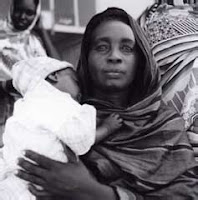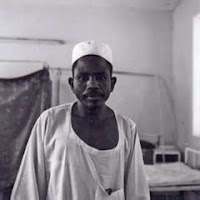In addition to the wonderfully rich Sudanese Arabic colloquialisms that wrapped up the last post, I have the pleasure of access to half a dozen other languages about which relatively little research has been done. Of all these none happens to be more interesting and more accessible than Midob, or Tidd-náal, as they call themselves. One of my closest neighbors is tiddi, and I came upon a locally-published monograph on everything Midob entitled Qabilat al-Midob: taht mijhar al-bahth “The Tribe of the Midob: under the microscope of research,” by al-Hajj Adam ‘Abdallah Hassan. While most of the work is based on collective memory of the recent past, and it does quote some western historians about the more distant past (including “English historian Makmaykel”), the author does valorize oral history:
post, I have the pleasure of access to half a dozen other languages about which relatively little research has been done. Of all these none happens to be more interesting and more accessible than Midob, or Tidd-náal, as they call themselves. One of my closest neighbors is tiddi, and I came upon a locally-published monograph on everything Midob entitled Qabilat al-Midob: taht mijhar al-bahth “The Tribe of the Midob: under the microscope of research,” by al-Hajj Adam ‘Abdallah Hassan. While most of the work is based on collective memory of the recent past, and it does quote some western historians about the more distant past (including “English historian Makmaykel”), the author does valorize oral history:
الجزء المدون من تاريخ الميدوب قليل ونادر واغلبها تعتمد على الروايات الشفوية فاجداد الميدوب يقولون انهم اتو من دنقلا ويدعي ال(كارقوى شلكوتا( بانهم من المحس (سكوت) ومنه اشتقوا لفظ شلكوتا ورواية اخرى تقول ان (الاورتى) هم المحس اما الكارقدى من الدناقلة. (8)
“The recorded part of the history of the Midob is few and far between, and seizing it depends on oral stories, so the grandfathers of the Midob say that they came from Dongola because our language and calls the Karqawi Shelkout because they are from the Muhiss (sukut) and from it they broke away from the remarks of the Shelkouta, and another story which says that the Aourti were the Muhiss as far as the Karqaday [Karqawi?] from Dongola.”
(forgive the translation)
Though we aren’t so lucky as to get any of this oral history written down verbatim (in Arabic or Midob) from the author, he does mention the names of some of his sources (two of whom live in my town), so maybe I will track them down or maybe just the author himself.
Besides just being quite accessible, Midob is of particular interest because it is related to Old Nubian reputedly, though it is the furthest linguistically and geographically from its purported medieval Nubian ancestor.
Roland Werner’s 1993 book on this branch of “Darfur Nubian” is reviewed below:
Roland Werner, Tidn-aal: a study of Midob (Darfur-Nubian). Berlin: Dietrich Reimer, 1993, 169 pp., DM68, ISBN 3 496 02507 7
The Midob are often referred to as ‘Meidob’: an erroneous spelling which does not reflect pronunciation and which goes back to a MacMichael 1918 article. Although the people have grown to accept the xenonym ‘Midob’, their self-name is tiddi (sg.) and their linguistic self-name is as in the title of this book , meaning ‘Tid (pl.) language’. The people live around Dar Midob, about 500 miles west of Khartoum. Werner says (p.13) the administrative area comprises 24,000 square miles. There are about 45,000 to 50,000 Midob, who are mixed pastoralists (goats, sheep, camels).
The introduction (pp. 13-18) takes up the name, location, tribe, place of Midob in Nubian, dialects and sub-groups, history of Midob linguistic research, methods, scope, and aim of the study.
The Midob are neither ‘Nile’ nor ‘Hill’ Nubians. According to the work of Becchauss-Gerst, Nubian consists of Nobiin (Mahas-Fadicca) as against four other languages, of which Midob is the most divergent. Midob was unknown to Western scholarship till MacMichael’s first published vocabulary list about 1912. Among the fifty bibliography items listed by Werner (pp. 167-9) there is no substantial grammar or dictionary of Midob, so that this book is the first such. A list of abbreviations is given on p. 166.
It contains an extensive Midob-English vocabulary of about 2,000 items (pp. 75-143) with Arabic loans identified and an English-Midob index (144-165). I obtained a copy just as I was in need of some Midob lexicon for a project but was surprised to discover that the English index does not list many basic terms such as ‘blood’ (although it is used on p. 25), ‘belly’, ‘claw’, ‘earth’, ‘feather’, ‘good’, ‘mouth’, ‘new’, ‘other’, ‘path’, ‘person’, ‘plant’, ‘road’, ‘seed’, or ‘smoke’. ‘See’ is given as kəl – on p. 159 but as kood – on p.46 and I could not find the latter in the lexicon. There are also two brief texts with translations (‘Of old times’ and ‘Wedding’, pp. 64-5) and 209 sentences (pp. 66-74).
The grammar is rather brief (pp. 18-63), consisting of (1) phonology, (2) tonology, (3) nouns, (4) pronouns, (5) postpositions, (6) the verb, (7) adverbs, (8) ideophones, (9) conjunctions. I will not go into any details here except to note that Arabic is invading the phonology and lexicon of Midob, as with all Sudanese languages.
The slim volume is well produced from what looks like computer print-out (with both margins justified)…. A sketch map of the location and general features of Dar Midob would have been helpful.
Despite some weaknesses, pointed out above, on balance this tone-marked grammar of Midob, based on fieldwork of 1987-88, is certainly a valuable addition to the Nubian linguistic literature.
M. Lionel Bender
Southern Illinois University
For a quicky wiki overview of contemporary Nubian languages see below:
“Of all the Nubian languages, the ones spoken along the Nile traditionally have received the most attention. Many manuscripts have been unearthed in the Nile Valley, mainly between the first and fifth cataracts, testifying to a firm Nubian presence in the area during the first millennium. Nobiin and a dialect cluster related to it, Kenzi-Dongolawi, are found in the same area. These languages were the languages of the Christian Nubian kingdoms. Historical comparative research has shown that the Nile-Nubian languages do not form a genetic unit; the speakers of Nobiin arrived first in the area, followed later by the speakers of the Kenzi and Dongolawi varieties.
“The other Nubian languages are found hundreds of kilometers to the southwest, in Darfur and in the Nuba Mountains of Kordofan. In the past, there has been debate as to whether the Nubian languages spread to the Nile valley from Kordofan and Darfur or moved in the opposite direction. For a long time it was assumed that the Nubian peoples dispersed from the Nile Valley to the south, probably at the time of the downfall of the Christian kingdoms. However, comparative lexicostatistic research in the second half of the twentieth century has shown that the spread must have been in the opposite direction (Thelwall 1982, Adams 1982, among others). Greenberg (as cited in Thelwall 1982) calculated that a split between Hill Nubian and the Nile-Nubian languages occurred at least 2,500 years ago. This account is corroborated by non-linguistic evidence — for example, the oral tradition of the Shaiqiya tribe of the Jaali group of arabized Nile-Nubians tells of coming from the southwest long ago.”
in the Nuba Mountains of Kordofan. In the past, there has been debate as to whether the Nubian languages spread to the Nile valley from Kordofan and Darfur or moved in the opposite direction. For a long time it was assumed that the Nubian peoples dispersed from the Nile Valley to the south, probably at the time of the downfall of the Christian kingdoms. However, comparative lexicostatistic research in the second half of the twentieth century has shown that the spread must have been in the opposite direction (Thelwall 1982, Adams 1982, among others). Greenberg (as cited in Thelwall 1982) calculated that a split between Hill Nubian and the Nile-Nubian languages occurred at least 2,500 years ago. This account is corroborated by non-linguistic evidence — for example, the oral tradition of the Shaiqiya tribe of the Jaali group of arabized Nile-Nubians tells of coming from the southwest long ago.”
Jay Spaulding has written an interesting article on the Shaiqiya tribe's relationship to Nubian, asserting that in fact they and several other riverain ethnic groups that have linguistically assimilated into the Arab majority spoke Nubian until a couple hundred years ago (and still retain traces of this in some of their speech)… a more detailed look at this will be in a forthcoming post addressing the question of whether and whither the different branches of the Nubian languages split… for now I leave you with a tree of how the branches of Nubian breakdown (thanks to the SIL Ethnologue):
* Nobiin (Not intelligible with Kenuzi-Dongola. Lexical similarity 67% with Kenuzi-Dongola)
o Mahas (Mahasi, Mahass)
o Fiyadikka (Fedicca, Fadicha, Fadicca, Fadija, Fiadidja)
* Kenuzi-Dongola (Not intelligible with Nobiin. Lexical similarity 67% with Nobiin, 56% with Debri)
o Dongola
o Kenuzi (Kenuz, Kunuzi)
* Midob or Meidob (Lexical similarity 51% with Birgid (closest)
o Shelkota (Shalkota)
o Kaageddi
o Urrti (Uurti)
* Birked/Birgid (extinct)
* ("Hill Nubian")
o Ghulfan (Wunci)
o Kadaru (Kodhin)
o Dilling (Lexical similarity 94% with Debri, 93% with Kadaru)
+ Dilling
+ Debri
o Dair (Thaminyi)
o El Hugeirat (El Hagarat)
o Karko (Kithonirishe)
o Wali




